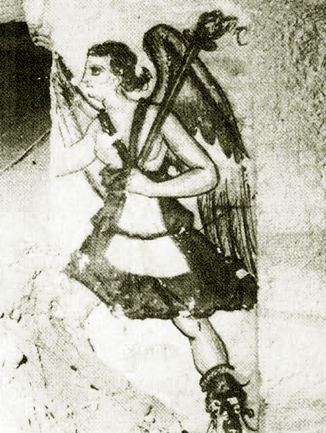Private Readings
Astrology readings any where in the World
Only £120 for 90mins via Skype.
Call 07767 810889 if you are in the UK or e-mail alison@alisonchesterlambert.com for elsewhere
For more information on Alison's readings or to see what people say about her click here
To watch a video trailer about the Astrology Reading Cards click on the image
Starry Messengers
Alison's first book was a limited first edition and that has now sold out. But it was re-published as the `Future in the Stars` and there are still a few personally signed copies of this for sale.
See the `Publications For Sale` page
on this website

TThe Future in the Stars
See the Publications for Sale page
on this website to buy this
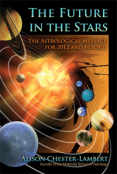
Click here to see review of
`Future in the Stars`
in Paradigm Shift
Click here to read a review of
`Future in the Stars`
on the RealAstrologers website
|
Vanth and Orcus. The Astrology of a New Guide Who Will Light the Way
By Alison Chester-Lambert
Just when you think you’ve got this Pluto/Underworld thing cracked, along comes another one. But Vanth has come with an illuminating light.....
It all began in 2003 when many dozens of scientists got together around a newly refurbished telescope and super digital camera, with the intention of increasing scientific understanding of Space. The different groups gleaned valuable baseline info on time dimensions, dark matter distribution, cosmic rays and energy generation. And (just before you drop off) they discovered planets! The new discoveries are all in the Kuiper Belt, a doughnut shaped ring that starts around Neptune’s orbit. It contains thousands of rocky objects and looks like a swarm of bees.
The survey of the Kuiper Belt revealed several planet-sized objects, one of which is bigger than Pluto, and these discoveries symbolise the change in collective consciousness as we move into the 21st century.
Orcus was discovered in 2004 and he is the 8th largest KBO, but it is his strange dance with Pluto that grabbed the attention of the discoverers. As you can see from the diagram, he moves in one direction at a jaunty angle to the main planets; and Pluto moves at a similar but opposite angle to the main planets. Interestingly, each has the same orbital period of about 248 years and currently they are very roughly 120° apart, with Pluto ABOVE the plane of the classical planets (called the Ecliptic) and Orcus BELOW it.
There are other similarities, too. Pluto is closer to the Sun than Neptune when he is at the top of his oval-shaped orbit as is Orcus when he is at the top of his. Pluto has a large moon called Charon and their two faces are locked towards each other as if they have an invisible shaft between them. So does Orcus and his moon, Vanth.
This so intrigued the imagination of the survey leader, Mike Brown; he dubbed Orcus(2) the “anti-Pluto”. He said of the Orcus myth that he read:
“Orcus was, essentially, the early Etruscan grim reaper, collecting the dead and bringing them to the Underworld where Pluto ruled……(then) Orcus lost his separate identity and Pluto became the master of all the functions of the dead……..In my new mythological/astronomical view, Pluto the KBO is now named after that earlier version of Pluto, before the Romans came along and swept everything together. And Orcus is his counterpart, destined to eventually be pushed aside by the rising Pluto.”
How Vanth Got Her Name
In March 2009, Mike Brown was putting the final touches to his scientific paper on the Moon of Orcus and needed a name for her. So, rather unusually he wrote a request for suggestions on his on-line blog.(3) For the next two weeks hundreds joined in the on-line game with various suggestions, but apparently only the Greek mythical figures of Cerberus and Phlegyas, or the Etruscan Vanth, were serious contenders. When considering the name of Vanth, he had this to say:
“Vanth is waiting for the dead, as she is often depicted. It even appears to me that she is silently crying while she waits. Admittedly, I might be misinterpreting, but still, the tear made me think of my sister, waiting for my father – guiding my father – as he took his last breaths……..wouldn’t it be nice to have someone who weeps for the dead? Wouldn’t it be nice to have a guide to light the way?”(5)
I’ve included all that detail for a very important reason, which will be revealed to you shortly. For little did Mike Brown know that as he wrote that, Vanth was desperately needed. He posted her name on Monday 6th April 2009, thereby awakening her energy in the collective consciousness; and never was a Goddess’s entrance more timely. For on that day, on the other side of the world, many of her people in the area around her homeland of Etruria were dying and would soon need their guide to light their way into the Underworld. Vanth had arrived just in time!
Before we get on to that tragedy, I need to include the final few lines that explain the choice of name to the international community. It reads:
“Vanth is a daimon in Etruscan mythology who guides the dead to the underworld. She often appears on tomb paintings and sarcophagi where she is depicted with wings and a torch, and she is frequently shown in the presence of Charun, a guard of the underworld.”(6)
Who Were the Etruscans?
A jolly good question! The original Etruscans came from or via Anatolia in Turkey(7), a fact that has been proven by matching up cattle DNA. They occupied Northern Italy from around 900BCE to 300BCE when they were eventually conquered by the Romans, but in their hey-day they influenced most of Italy. They were an extremely skilled and advanced race with many unusual characteristics that would be copied by the Romans. In 1970 Dr Werner Keller wrote:
“Historically, one thing is certain. When the Etruscans spread their advanced civilisation and culture in Italy, at a time when all else there was prehistoric, they set in motion the emergence and ascendance of Western Europe.”(8)
Apparently, the Romans so relied on them that after the fall of the Etruscan kings, Rome was completely unable to provide education for their own children(9) and much of the Renaissance art had its roots in Etruscan carvings.
Etruscan Religion
Evidence of the exceptional hydraulic engineering and sophisticated sewage/water systems of the Etruscans is easy for archaeologists to point out. However, all their religious written works and paraphernalia were systematically destroyed by the Romans, although this hasn’t stopped the archaeologists and historians from writing their own interpretations.
Sometimes this is an acceptable opinion to use when assessing the meaning of a new planet, since it is, after all, the collective belief which the planet will represent. But there is also a need to understand what that god/dess meant to the indigenous people; to understand what it was that they needed or sought from that god in order that s/he should be brought into existence. To this end we need to look for evidence uncontaminated by surmising and conjecture.
A lady called Nancy Thomson de Grummond has written a treasure of a book called `Etruscan Myth, Sacred History and Legend` which simply records the few surviving religious artefacts in detail and was therefore useful for drawing together the following basic facts.(10)
The Etruscans did have their own god/desses although there was some cross-pollination with the Greek pantheon, which was inevitable since they were all trading with each other. The Etruscan pantheon could change sex, not an un-usual feature in ancient times. The god associated with the Underworld was called Aita and in later times the chief god was a Zeus-like figure called Tinia, who often features giving birth to Fuflens, the Etruscan equivalent of Dionysus (from his thigh) and Menrva, the Etruscan equivalent of Athena (from his head).
An apparent big difference is that Tinia was the grandfather of Tages, who appeared as a prophet-child in Etruria one day and gave long and detailed information about sacred doctrine and the art of divination by inspecting the liver of an animal, or by `reading` lightening, thunder and earthquakes. I just love a translation in Nancy’s book of an Etruscan prophecy for June 16th which reads:
“If in any way it should thunder, it threatens not only dearth of the necessities of life but also war, while a prosperous man shall disappear from public life.”(11)
(Reading that on June 16th 2009 whilst considering climate change, predictions of future food scarcity, the war in Afghanistan and Gordon Brown’s last stand, it seems some things just never change! In the meantime, shouldn’t somebody find out if it thundered or not?)
Charun is a hammer-carrying Underworld deity who features a lot; and at one time over the centuries was associated with re-birth, fertility and wealth. This may seem strange to us now, but they also had a whole different take on Pluto/Aita, who was once associated with wealth and thought to come from a favourable region of the sky along with Eris.(12) As with modern astrology, the celestial canopy was divided into `houses` in a 16 part sky and it was here the Etruscan gods (planets?) dwelt, supported by dozens of different spirits. The god/desses could inhabit more than one house, which of course, is like the planets in transiting astrology.
It seems they were extremely skilled at divination and had highly developed religious practises which completely and absolutely depended on consultation with their gods over everything. According to Dr Keller:
“The Etruscan Discipline reflects a sense of close union with the cosmos…a profound inter-connection of all elements in a mystic unity that joined the celestial and terrestrial worlds with the underworld. Everything on Earth, the life of the individual as well as that of the nation, is integrated in the unalterable rhythm of creation. Nothing is due to chance. Every event is preordained. The individual and the people are at the mercy of the gods, subject to the will of the unfathomable powers…... Man’s whole care seems to have been to find out the will of the deity from the signs it gave and to use every imaginable method to secure its benevolence….”(13)
Prophecy is included in most of the few surviving relics, often involving a hand mirror, which makes one wonder about the origins of “Mirror, mirror, on the wall, who is the fairest of them all?”
One particular treasure gives a lot of clues about their cosmology and astrology. It is a brass liver (Yep, liver…… the sort you normally see with onions) with regions marked off and the name of gods (or planets) who are favourable in those particular `houses`. It is similar to the list of Exaltations that we use in western astrology.
There was a mysterious group called the Shrouded Gods who were immensely powerful; plus 12 counselling gods who were ruled over by Tinia. The Etruscans actually lived in 12 separate `counties` to reflect this.
The Etruscans lived in a 3-dimensional `horoscope`. It was quartered by a north/south axis and east/west axis, with a deep shaft pointing to the I.C., and everything was based on the division of space,(14) as it is with our horoscopes. It is amusing to see that the “terrible and merciless gods of the Underworld and fate” dwelt in the north-west portion, the equivalent of the 8th house in astrology. There are many today who will therefore agree with them!
Symbols of the Etruscan Underworld include the wolf(15) and engravings show people trying to slit it's throat. Other symbols include very large snakes and a hammer, which turns out to be very important as we shall see later.
Orcus in Mythology
Scholarly European authors state that the Etruscans called the god of the Underworld Pluto, Hades or Aita and there is no mention of the name Orcus. The source of the myth used by Mike Brown to name the planet is uncited and so un-researchable, (he states in an e-mail that he just did a Google search and took no notes) and there is little on Orcus elsewhere. The words Hades or Orcus could be used to describe the ancient Italian Underworld realm or the god and these names seemed to become more popular with the frightening or evil version of the Underworld that emerged from around 300BCE onwards and became the iconic `burning-hell-fire` image of the Christian era.
In earlier centuries in the Mediterranean and ancient Near-East civilisations, it was not a terrifyingly evil place. The burning-hell-fire image must have come from Italian experience of volcanic eruptions; Mount Vesuvius is the only active volcano in Europe and the country is close to the Europe-Africa fault line.
Despite a thorough search by this author, the name Orcus only appeared with reference to an Italian triple-roomed tomb called the Tomb of Orcus and it is likely that this is what Mike Brown found in his Google search. However, the name Orcus appears to be a Latin or Roman name given to the tomb after the demise of the Etruscan race. The tomb was first constructed in the 4th century BCE and then added to 2 centuries later. The earlier walls have scenes of banqueting, dancing and flute playing which reflect some celebration of the Underworld experience.(16)
The Etruscan Religious Devotion to Divination Morphed into Christian Religious Suppression of Prophecy
The apparent intensity of the Etruscan devotion to divination and prophesy was countered by the backlash of devotion to it’s annihilation by the Roman Catholic church. Orcus the 'planet' may therefore serve as another celestial example of the slackening of zealous Christian faith as we move into the 21st century.
Painting of Tuchulcha copyright Robbi 07772 479380
The Roman Emperor Claudius insisted in a speech to the senate in 47AD that the Etruscan’s exceptional divination skills should not be lost and proposed the establishment of a college to preserve their art.(20) But the pagan ways were a dangerous inheritance to the newly emerging Christian religion and everything pertaining to Etruria was ruthlessly and bloodily wiped out, thus confirming the accuracy of the Etruscan powers, since they had forecast this extermination centuries before and turned out to be completely right to within a couple of years!
Strangely, another example of this backlash to prophecy even occurred recently. An Italian scientist predicted a major earthquake around the town of L’Aquila before it actually happened in April 2009. He used a vehicle from the National Institute of Astrophysics to drive around the town and issue the warning. The Mayor reported him to the police and he was actually silenced and put under police surveillance for spreading alarm. His web site was forcibly shut down. It seems the post-Etruscans Italians are still overly sensitive to prediction!
All this was happening as Mike Brown was holding his on-line `auction` to name Vanth and it is interesting to see the synchronicity at work.
Vanth is definately Etruscan, she was one of a throng of winged spirits who always accompanied Charun and the ugly Tuchulcha, and her appearances were always associated with death(21) and implacable fate. She is a pretty thing with bare breasts, a short skirt, hunting boots and a flaming torch to light the way. She was said to hover over scenes of battle or killing ready to lead the souls away to the Underworld.(22)
Vanth Arrives Just in Time to Light the Way of the Victims of the L’Aquila Earthquake Into the Underworld
As Mike Brown was preparing to tell the world of how Vanth had named herself, tragedy struck at the heart of her homeland of Italy. The town of L`Aquila was devastated by an earthquake that killed hundreds of people whilst they slept. The astrology of the time describes how Orcus and Vanth were involved in this. Sadly earthquakes do happen; and whilst Orcus and Vanth didn’t actually perpetrate the event, they were ready to receive the souls who were released by it.
The chart of the Republic of Italy(23) has a Midheaven at 29° of Leo, and on Monday 6th April transiting Orcus and Vanth were conjunct that Midheaven at 29° Leo. They were accompanied by Ceres at 0° Virgo and the Moon at 1° Virgo. The Moon’s passage over the 29° Leo a few hours earlier would have triggered the event and the goddesses Ceres and Vanth were silently waiting in the night sky. Perhaps their trine to Pluto who was at 3° Capricorn, assisted theri path to the Underworld.
So just in time, Vanth had emerged to hover over the town, ready with her flaming torch to light the way of the newly released souls into the Otherworld. In their confusion and disorientation, how comforted they must have been to be guided by Vanth and Ceres.
The Reason for the Underworld Symbols of the Etruscans
Interestingly The Times(24) described monstrous thuds heard during the quake and a L’Aquila resident was reported as saying “It was like a giant hammer underneath the ground, thumping beneath us – boom, boom, boom.” This is fascinating when one remembers that the Etruscan Underworld deities carried hammers with which to smash the skulls of their victims. One is left wondering whether this is a co-incidence, or was the Etruscan model of the Underworld based on the hammering coming up from the Earth during an earthquake? So many times in my work I see how deity is based on the natural features surrounding that civilisation.
Vanth and many of her associates have wings, which speaks of their ability to fly up to the god/desses in the sky. Birds were often depicted in Etruscan art and their migratory habits were probably used to navigate ships and locate land. The image of winged spirits or deity was carried through into Catholic Christian art.
In the astrology of the 21st century we have clear symbolism of the emergence of guides to the other realms through the arrival of Charun, the Greek ferryman and now Vanth. Her symbol is the flaming torch which is an emblem of new life and resurrection(25) from darkness; a lovely symbol for an Underworld deity to have as science gets closer to discovering dark energy and dark matter in the Universe. It is interesting to contemplate that Orcus may represent the realm or dimension and Vanth may be the guide to it.
If Vanth is here to shed light in the dark and guide our path - a beautiful illuminator - shall we follow her?
I think so!
Alison Chester-Lambert © 2009
REFERENCES:
(1) BROWN, M. (23 March 2009) S/1 90482 (2005) needs your help Mike Brown’s Planets: http://www.mikebrownsplanets.com/search?updated-max=2009-03-29T11%3A45%3A00-07%3A00&max-results=7
(2) BROWN, M ibis (23/3/2009)
(3) BROWN, M ibis (23/3/2009)
(5) BROWN, M. (6th April 2009) Orcus Porcus. Mike Brown’s Planets: http://www.mikebrownsplanets.com/2009_04_01_archive.html
(6) BROWN, M ibis (6/4/2009)
(7) DAY, M. (14/2/2007) On the Origin of he Etruscan Civilisation; New Scientist: http://www.newscientist.com/article/dn11174-on-the-origin-of-the-etruscan-civilisation.html
(8) KELLER, W. (1975) The Etruscans. England: The Book Club Associates.
(9) KELLER, W. (1975) ibid
(10) THOMSON de GRUMMOND, N. (2006) Etruscan Myth, Sacred History and Legend Google Books; http://books.google.com/books/p/pennpress?q=orcus&hl=EN&vid=9781931707862&btnG=Go#v=onepage&q=aita&f=false
(11) THOMSON de GRUMMOND, N. (2006) ibid
(12) THOMSON de GRUMMOND, N. (2006) ibid
(13) KELLER, W. (1975) ibid pp 81
(14) KELLER, W. (1975) ibid pp83
(15) THOMSON de GRUMMOND, N. (2006) ibid
(16) WELLARD, J. (1973) The Search for the Etruscans. London: Thomas Nelson and Sons
(17) RASNA BOARD, (last modified 12/10/2009) The Tomb of Orcus; The Mysterious Etruscans http://www.mysteriousetruscans.com/tarorcus.html
(19) BULFINCH, T. (1978 edition) Bulfinch’s Mythology. New York: Avenel Books
(20) KELLER, W. (1975) ibid pp79
(21) Thomson de Grummond, N. (2006) ibid pp13
(22) KELLER, W. (1975) ibid
(23) http://www.astrologyweekly.com/countries/italy.php
(24) OWEN, R. (7/4/2009) Italian Earthquake: Nothing to See But Devastation in L’Aquila; The Times: http://www.timesonline.co.uk/tol/news/world/europe/article6044927.ece
(25) BLAVATSKY, H. (1877) Isis Unveiled; Sacred Texts: http://www.sacred-texts.com/the/iu/iu109.htm
Bibliography
As above plus:
The Mysterious Etruscans. www.mysteriousetruscans.com
Hope Moncrieff, A.R. (1907) Classical Mythology. Myths and Legends. (Ed 1994); London: Studio Editions Ltd.
RADICE, B. (1971) Who’s Who in the Ancient World. England: Penguin Books Ltd
ANON. (2002) Vanished Civilisations. London: Readers Digest Association
ANON (1974) The Last Two Million Years. London: Readers Digest Association
Illustrations:
Diagram of Solar System by Robbi Lambert ©2009
Image of Vanth from www. ilcancello.com
|
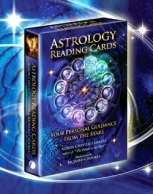


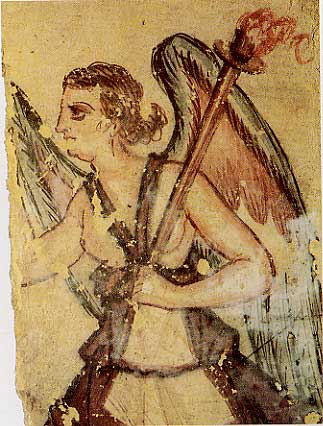
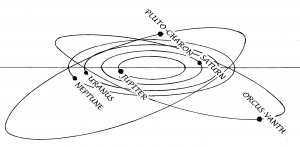 As you can see from the diagram, the Kuiper Belt Objects (KBO’s) do not orbit on the same plane as the classical planets It’s all a bit chaotic out there with stuff moving about in elongated, oval-shaped orbits, because the gravity of the mighty Neptune pushes things around(1).
As you can see from the diagram, the Kuiper Belt Objects (KBO’s) do not orbit on the same plane as the classical planets It’s all a bit chaotic out there with stuff moving about in elongated, oval-shaped orbits, because the gravity of the mighty Neptune pushes things around(1).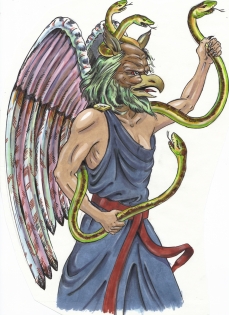 The difference in the subjects from the first period to the next reflects the tendency towards more evil, demonic figures(17) that was becoming characteristic of Etruscan art during the last centuries of their existence. Charun is winged with an evil face, although Aita (Hades) seems handsome enough, albeit in a wolf skin. Joining them is Tuchulcha, an Underworld deity whose prime task seems to be to frighten to death the already dead. He has the face of a vulture, the ears of a donkey and snake-infested hair. Giant serpents writhe around his arms.
The difference in the subjects from the first period to the next reflects the tendency towards more evil, demonic figures(17) that was becoming characteristic of Etruscan art during the last centuries of their existence. Charun is winged with an evil face, although Aita (Hades) seems handsome enough, albeit in a wolf skin. Joining them is Tuchulcha, an Underworld deity whose prime task seems to be to frighten to death the already dead. He has the face of a vulture, the ears of a donkey and snake-infested hair. Giant serpents writhe around his arms.